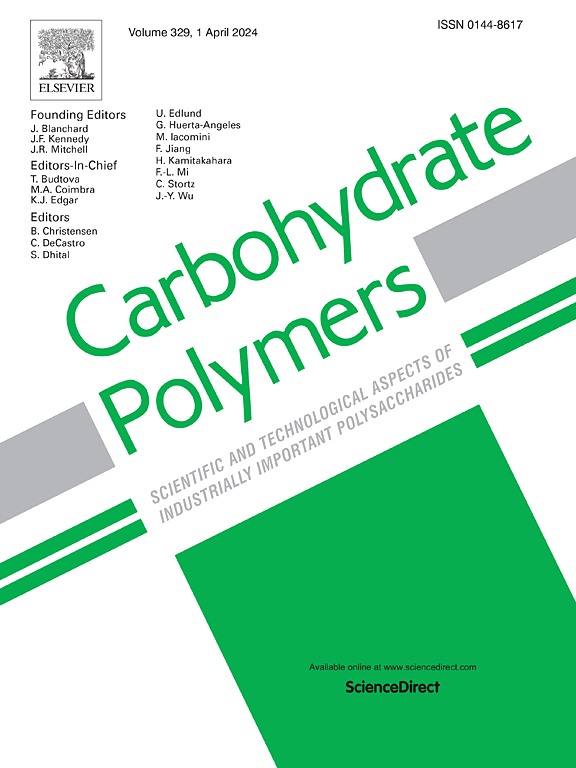Bioinspired cholesteric CNC-based photonic hydrogels with enhanced mechanical properties and dynamic structural color for multifunctional optical applications
IF 10.7
1区 化学
Q1 CHEMISTRY, APPLIED
引用次数: 0
Abstract
The natural bouligand architecture endows crustacean exoskeletons with an exceptional combination of mechanical strength and vibrant chiroptical characteristics. However, fabricating photonic hydrogels that possess both mechanoresponsive color-changing capabilities and excellent mechanical strength remains a significant challenge. Herein, intelligent cellulose nanocrystal (CNC)-based photonic hydrogels with enhanced mechanical properties are obtained through a one-step synthesis process. Precise control over equilibration time of CNC and acrylamide (AM) precursors is essential for achieving long-range ordered structures within the hydrogels, which is also necessary for their mechanochromic response to pressure and tensile forces. The resulting hydrogels demonstrated high strength (257 KPa), toughness (405 KJ m−3), and elasticity (310 %), which far exceed the hydrogels with short-range ordered and completely disordered structures. These results are attributed to the ordered and stiff chiral nematic structure of CNCs, which are seamlessly embedded into the physically crosslinked soft PAM matrix due to favorable dynamic hydrogen bonding. Distinctive stress sensitivities in structural color of hydrogels are realized by controlling the reassembly angles of CNC and AM precursors. Furthermore, two types of anticounterfeiting labels are constructed by applying their mechanochromic characteristics and specific stress sensitivities, which offer enhanced information encryption over traditional labels.

具有增强机械性能和动态结构色彩的多功能光学应用的仿生胆甾型cnc光子水凝胶
天然的砾石结构赋予了甲壳类动物的外骨骼一种特殊的结合机械强度和充满活力的热带特征。然而,制造既具有机械反应变色能力又具有优异机械强度的光子水凝胶仍然是一个重大挑战。本文通过一步合成工艺获得了具有增强力学性能的智能纤维素纳米晶体光子水凝胶。精确控制CNC和丙烯酰胺(AM)前驱体的平衡时间对于实现水凝胶内的远程有序结构至关重要,这也是它们对压力和张力的机械变色响应所必需的。所制备的水凝胶具有较高的强度(257 KPa)、韧性(405 KJ m−3)和弹性(310%),远远超过了具有短程有序和完全无序结构的水凝胶。这些结果归因于cnc的有序和刚性手性向列结构,由于有利的动态氢键,cnc可以无缝嵌入物理交联的软PAM矩阵中。通过控制CNC和AM前驱体的重组角度,实现了水凝胶结构颜色的不同应力敏感性。此外,利用其机械变色特性和特定应力敏感性,构建了两种类型的防伪标签,提供了比传统标签更强的信息加密。
本文章由计算机程序翻译,如有差异,请以英文原文为准。
求助全文
约1分钟内获得全文
求助全文
来源期刊

Carbohydrate Polymers
化学-高分子科学
CiteScore
22.40
自引率
8.00%
发文量
1286
审稿时长
47 days
期刊介绍:
Carbohydrate Polymers stands as a prominent journal in the glycoscience field, dedicated to exploring and harnessing the potential of polysaccharides with applications spanning bioenergy, bioplastics, biomaterials, biorefining, chemistry, drug delivery, food, health, nanotechnology, packaging, paper, pharmaceuticals, medicine, oil recovery, textiles, tissue engineering, wood, and various aspects of glycoscience.
The journal emphasizes the central role of well-characterized carbohydrate polymers, highlighting their significance as the primary focus rather than a peripheral topic. Each paper must prominently feature at least one named carbohydrate polymer, evident in both citation and title, with a commitment to innovative research that advances scientific knowledge.
 求助内容:
求助内容: 应助结果提醒方式:
应助结果提醒方式:


